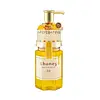What's inside
What's inside
 Key Ingredients
Key Ingredients

No key ingredients
 Benefits
Benefits

 Concerns
Concerns

 Ingredients Side-by-side
Ingredients Side-by-side

Water
Skin ConditioningSodium Methyl Cocoyl Taurate
CleansingSodium Laureth Sulfate
CleansingCocamidopropyl Betaine
CleansingPEG-2 Laurate
EmulsifyingGlycol Distearate
EmollientSodium Chloride
MaskingGuar Hydroxypropyltrimonium Chloride
Skin ConditioningPolyquaternium-10
Taurine
BufferingHydrolyzed Oat Protein
Skin ConditioningTriticum Vulgare Germ Oil
EmollientDipropylene Glycol
HumectantCitric Acid
BufferingSodium Edtmp
Butylene Glycol
HumectantSodium Benzoate
MaskingPhenoxyethanol
PreservativeParfum
MaskingWater, Sodium Methyl Cocoyl Taurate, Sodium Laureth Sulfate, Cocamidopropyl Betaine, PEG-2 Laurate, Glycol Distearate, Sodium Chloride, Guar Hydroxypropyltrimonium Chloride, Polyquaternium-10, Taurine, Hydrolyzed Oat Protein, Triticum Vulgare Germ Oil, Dipropylene Glycol, Citric Acid, Sodium Edtmp, Butylene Glycol, Sodium Benzoate, Phenoxyethanol, Parfum
Cyclopentasiloxane
EmollientDimethicone
EmollientHydrogenated Polyisobutene
EmollientElaeis Guineensis Kernel Oil
EmollientHoney
HumectantHoney Extract
HumectantHydrolyzed Honey Protein
Skin ConditioningRosa Damascena Flower Extract
MaskingArgania Spinosa Kernel Oil
EmollientPanthenol
Skin ConditioningGluconobacter/Honey Ferment Filtrate
Skin ConditioningKeratin
Skin ConditioningRoyal Jelly Extract
Skin ConditioningPropolis Extract
Skin ConditioningC9-11 Alkyl Glucoside
CleansingHydroxypropyltrimonium Hyaluronate
Ceramide Ng
Skin ConditioningCeramide NP
Skin ConditioningCeramide AP
Skin ConditioningHydrolyzed Silk
HumectantGlycerin
HumectantTocopherol
AntioxidantQuaternium-18
Quaternium-33
Cholesterol
EmollientButylene Glycol
HumectantPropylene Glycol
HumectantPhenoxyethanol
PreservativeWater
Skin ConditioningParfum
MaskingCyclopentasiloxane, Dimethicone, Hydrogenated Polyisobutene, Elaeis Guineensis Kernel Oil, Honey, Honey Extract, Hydrolyzed Honey Protein, Rosa Damascena Flower Extract, Argania Spinosa Kernel Oil, Panthenol, Gluconobacter/Honey Ferment Filtrate, Keratin, Royal Jelly Extract, Propolis Extract, C9-11 Alkyl Glucoside, Hydroxypropyltrimonium Hyaluronate, Ceramide Ng, Ceramide NP, Ceramide AP, Hydrolyzed Silk, Glycerin, Tocopherol, Quaternium-18, Quaternium-33, Cholesterol, Butylene Glycol, Propylene Glycol, Phenoxyethanol, Water, Parfum
 Reviews
Reviews

Ingredients Explained
These ingredients are found in both products.
Ingredients higher up in an ingredient list are typically present in a larger amount.
Butylene Glycol (or BG) is used within cosmetic products for a few different reasons:
Overall, Butylene Glycol is a safe and well-rounded ingredient that works well with other ingredients.
Though this ingredient works well with most skin types, some people with sensitive skin may experience a reaction such as allergic rashes, closed comedones, or itchiness.
Learn more about Butylene GlycolParfum is a catch-all term for an ingredient or more that is used to give a scent to products.
Also called "fragrance", this ingredient can be a blend of hundreds of chemicals or plant oils. This means every product with "fragrance" or "parfum" in the ingredients list is a different mixture.
For instance, Habanolide is a proprietary trade name for a specific aroma chemical. When used as a fragrance ingredient in cosmetics, most aroma chemicals fall under the broad labeling category of “FRAGRANCE” or “PARFUM” according to EU and US regulations.
The term 'parfum' or 'fragrance' is not regulated in many countries. In many cases, it is up to the brand to define this term.
For instance, many brands choose to label themselves as "fragrance-free" because they are not using synthetic fragrances. However, their products may still contain ingredients such as essential oils that are considered a fragrance by INCI standards.
One example is Calendula flower extract. Calendula is an essential oil that still imparts a scent or 'fragrance'.
Depending on the blend, the ingredients in the mixture can cause allergies and sensitivities on the skin. Some ingredients that are known EU allergens include linalool and citronellol.
Parfum can also be used to mask or cover an unpleasant scent.
The bottom line is: not all fragrances/parfum/ingredients are created equally. If you are worried about fragrances, we recommend taking a closer look at an ingredient. And of course, we always recommend speaking with a professional.
Learn more about ParfumPhenoxyethanol is a preservative that has germicide, antimicrobial, and aromatic properties. Studies show that phenoxyethanol can prevent microbial growth. By itself, it has a scent that is similar to that of a rose.
It's often used in formulations along with Caprylyl Glycol to preserve the shelf life of products.
Water. It's the most common cosmetic ingredient of all. You'll usually see it at the top of ingredient lists, meaning that it makes up the largest part of the product.
So why is it so popular? Water most often acts as a solvent - this means that it helps dissolve other ingredients into the formulation.
You'll also recognize water as that liquid we all need to stay alive. If you see this, drink a glass of water. Stay hydrated!
Learn more about Water